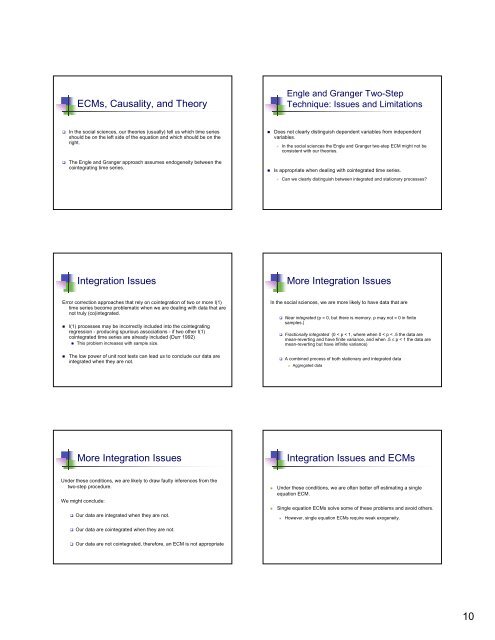An Introduction to Error Correction Models An Introduction to ECMs ...
An Introduction to Error Correction Models An Introduction to ECMs ...
An Introduction to Error Correction Models An Introduction to ECMs ...
Create successful ePaper yourself
Turn your PDF publications into a flip-book with our unique Google optimized e-Paper software.
<strong>ECMs</strong>, Causality, and Theory<br />
� In the social sciences, our theories (usually) tell us which time series<br />
should be on the left side of the equation and which should be on the<br />
right.<br />
� The Engle and Granger approach assumes endogeneity between the<br />
cointegrating time series.<br />
Integration Issues<br />
<strong>Error</strong> correction approaches that rely on cointegration of two or more I(1)<br />
time series become problematic when we are dealing with data that are<br />
not truly (co)integrated.<br />
� I(1) processes may be incorrectly included in<strong>to</strong> the cointegrating<br />
regression - producing spurious associations - if two other I(1)<br />
cointegrated time series are already included (Durr 1992)<br />
� This problem increases with sample size.<br />
� The low power of unit root tests can lead us <strong>to</strong> conclude our data are<br />
integrated when they are not.<br />
More Integration Issues<br />
Under these conditions, we are likely <strong>to</strong> draw faulty inferences from the<br />
two-step procedure.<br />
We might conclude:<br />
� Our data are integrated when they are not.<br />
� Our data are cointegrated when they are not.<br />
� Our data are not cointegrated, therefore, an ECM is not appropriate<br />
Engle and Granger Two-Step<br />
Technique: Issues and Limitations<br />
� Does not clearly distinguish dependent variables from independent<br />
variables.<br />
� In the social sciences the Engle and Granger two-step ECM might not be<br />
consistent with our theories.<br />
� Is appropriate when dealing with cointegrated time series.<br />
� Can we clearly distinguish between integrated and stationary processes?<br />
More Integration Issues<br />
In the social sciences, we are more likely <strong>to</strong> have data that are<br />
� Near integrated (p = 0, but there is memory. p may not = 0 in finite<br />
samples.)<br />
� Fractionally integrated (0 < p < 1, where when 0 < p < .5 the data are<br />
mean-reverting and have finite variance, and when .5 ≤ p < 1 the data are<br />
mean-reverting but have infinite variance)<br />
� A combined process of both stationary and integrated data<br />
� Aggregated data<br />
Integration Issues and <strong>ECMs</strong><br />
� Under these conditions, we are often better off estimating a single<br />
equation ECM.<br />
� Single equation <strong>ECMs</strong> solve some of these problems and avoid others.<br />
� However, single equation <strong>ECMs</strong> require weak exogeneity.<br />
10


